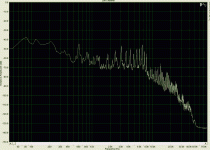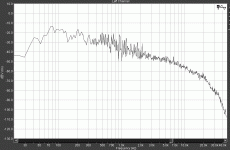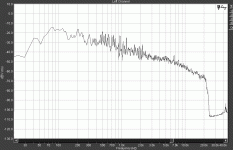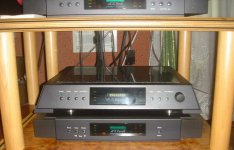Only money counts theses days.
As someone who's been around long enough to remember the "Golden Days of Audio," I can assure you 'twas ever thus.
I don't know where this plays in, but one difference in LP's and CD's is in the degree of channel separation. I think that 25dB would be very good for a cartridge in practice. A CD would be much higher. I would think that this would have an audible effect on imaging. Better separation doesn't necessarily mean better imaging (by which I mean a more effective illusion).
Sheldon
Sheldon
Sheldon said:I don't know where this plays in, but one difference in LP's and CD's is in the degree of channel separation. I think that 25dB would be very good for a cartridge in practice. A CD would be much higher
One of my sonically most favorite LP's is Ella Fitzgerald - Whisper Not. Verve V-4071, MONO, about 1965. I wish that any CD stereo mastering would sound that good is this old mono ...
Agreed PMA. I actually have some early stereo recordings that sound better in mono, because the separation is so distinct that I hear two sound sources instead of a reconstructed stage. I was hinting at the possibility that better separation specs. don't necessarily translate into a more natural presentation. I can imagine that there are subtle phase issues that play into this.
Sheldon
Sheldon
I don't know where this plays in, but one difference in LP's and CD's is in the degree of channel separation. I think that 25dB would be very good for a cartridge in practice. A CD would be much higher. I would think that this would have an audible effect on imaging. Better separation doesn't necessarily mean better imaging (by which I mean a more effective illusion).
Hi, Sheldon,
I feel that LP has much wider and better spatial sound stage. This is confusing, despite it has worse separation (technical specs).
Do you know what is the max frequency obtainable from LP? (CD is 22.05khz).
Which is the right one for difference between CD-LP? :
-Work mechanism of CD. I don't understand what is the downside, but some members said CD is not perfect, has flaw inherent in its process of reproduction.
-Mastering difference between CD and LP
-LP has more distortion
For me the interesting one is no.3. I can hear that LP is noisier and has more distortion, but the final result, the music is heard better.
Can I say that so called "Distortion" (non-perfect output-input relation) is in some degree (certain kind of distortion and certain magnitude) is actually preferable to our ear? (Hi, PMA, don't be angry with me
Maybe it's easier to make amp/recording that has very clean THD, S/N content.
But it must be very difficult to make amp/recording that has that "preferable" distortion to our ear. The right one in the right doze. I don't know which kind of distortion that is, and how much that is, though.
a possible reason why
I've been thinking about the soundstage issue for some time, not wrt LP but in general. Now, on the speaker side, airy, wide and deep presentation often is attributed to
- speakers well away from room surfaces
- speakers are dipoles
- speakers are line sources
Now compare with human hearing psychoacoustics - reflections in the 5-50 ms delay range are perceived as adding air, and can actually enhance speech intelligibility. Added clue: headphone sound just doesn't sound natural in the way of a real soundstage.
Putting 2 and 2 together I suspect the same issue relates the above with the soundstage of LP vs CD: it appears to me that the ear wants basically a phase / delay mix - one that is to some extent jumbled up (within reason).
Room reflections will do this naturally. Dipoles will radiate strongly to the rear and enhance this part of room reflections. In fact my dipoles sound best really far away from the source, possibly in another room of the house - then, with plenty of reflections added, do they sound at their most natural. And line sources might actually simulate room reflections because of the varying ear-to-source distances along the line, and so create their large soundstage. So maybe, as some posts suggested, poorer channel separation and other factors subtly affecting phase response on LP's also manage to simulate airy, wide soundstages.
I confess I have not been listening to any LPs in years. But I often preferred them to CDs, before I succumbed to practicality.
Oh yeah, another clue: airiness of NOS DACs w/o anti-aliasing filters...
I've been thinking about the soundstage issue for some time, not wrt LP but in general. Now, on the speaker side, airy, wide and deep presentation often is attributed to
- speakers well away from room surfaces
- speakers are dipoles
- speakers are line sources
Now compare with human hearing psychoacoustics - reflections in the 5-50 ms delay range are perceived as adding air, and can actually enhance speech intelligibility. Added clue: headphone sound just doesn't sound natural in the way of a real soundstage.
Putting 2 and 2 together I suspect the same issue relates the above with the soundstage of LP vs CD: it appears to me that the ear wants basically a phase / delay mix - one that is to some extent jumbled up (within reason).
Room reflections will do this naturally. Dipoles will radiate strongly to the rear and enhance this part of room reflections. In fact my dipoles sound best really far away from the source, possibly in another room of the house - then, with plenty of reflections added, do they sound at their most natural. And line sources might actually simulate room reflections because of the varying ear-to-source distances along the line, and so create their large soundstage. So maybe, as some posts suggested, poorer channel separation and other factors subtly affecting phase response on LP's also manage to simulate airy, wide soundstages.
I confess I have not been listening to any LPs in years. But I often preferred them to CDs, before I succumbed to practicality.
Oh yeah, another clue: airiness of NOS DACs w/o anti-aliasing filters...
I strongly believe that most of concerns are caused by improper CD playback. Jitter, HF residuals, DAC quality, filter algorithm and noise background. I have heard several excellent DACs to which LP can never compare. In general - with commercial CD player production excellent DACs are unfortunately only a dream.
Hi, PMA,
Thanks LP seems can do 40-50khz? Is there any kind of CD system (SACD, XRCD, HDCD?) that also can do this?
LP seems can do 40-50khz? Is there any kind of CD system (SACD, XRCD, HDCD?) that also can do this?
I also confused by this. There is a device called upsampler (Elgar?). If the CD itself has data only up to 22.05khz, how can this device makes "more complete" sound? Where the data coming from?
Thanks
I also confused by this. There is a device called upsampler (Elgar?). If the CD itself has data only up to 22.05khz, how can this device makes "more complete" sound? Where the data coming from?
lumanauw said:Hi, PMA,
ThanksLP seems can do 40-50khz? Is there any kind of CD system (SACD, XRCD, HDCD?) that also can do this?
I have several SACD (Telarc, pure DSD) classical music recordings with spectra up to 40kHz.
It also depends on microphones used, they must be with small diaphragm diameter. Anyway, best B+K mikes go up to 100kHz.
Here the same in 16bit/44.1kHz. Simultaneous recording of the same music. And these 2 tracks do sound different.
http://mixonline.com/mag/audio_resolution_project/
http://mixonline.com/mag/audio_resolution_project/
Attachments
clem_o said:
Hi David,
Maybe not -
There was at least one company that thought 16/44 wasn't good enough, (Decca?), they wanted it up'd to 20/44 at least. I think, just like any technology, there are tradeoffs that are considered and in this case playback time was the issue (they wanted to fit a symphony into one disk, don't remember which particular symphony and it happened to be ~70 minutes long).
Also, why would Sony et al introduce SACD (well, ok, aside from reducing bootlegging)?
The kinds of distortions / problems between LP and CD are very different (i.e analog distortions versus digital), and perhaps the bottom line is, the 'problems' with CD are just more annoying to the human ear.
Cheers!
Clem
dear all,
a bit of background on the CD format:
The disc should be max 12cm. Marketeers wanted it smaller, but that wasn't feasible. They then had special blouses made with 12cm wide pockets on the chest, to show how easy you could stow away a disc.....
A certain Beethoven symphony(don;t remember which) should fit on the disc, so 74 minutes playing time was set as standard. then came 20kHz bandwidth, and with the given disc technology of those days, 16 bits where the results. The inner hole by the way has the size of a Dutch dubbeltje (todays equivalent is 5 eurocent). The inner radius was defined by popular motors present, used in compact casette recorders (27mm).
Once that was settled, Philips converted their existing 11 bit industrial DAC to 14 bits (TDA1540), bigger wasn't possible within DIL packages by that time. Because these converters had 200kHz bandwidth, 4 times oversampling just fitted in.
So far the history, people knew better formats where possible, but not in the given limitations.
Given a concept, its' implementation finally defines the potential results. What matters is known, 25 years after the introduction of the format.
I have a Voyd turntable, with AudioNote IO cartridge and some nice tube amplification, choice of 2 speakers (Audio Note type E and Ensemble) so I know a bit how vinyl can sound. On the other hand, my (and others') digital gear is up to a level that is very close to vinyl playback.
SACD and other formats offer more potential than CD but again require proper implementation. In an effort to make SACD popular, prices of players went down very rapidly, and quality suffers.......
best
Ok, how about this one:
Digital distortion quotes are referenced against the full scale (16 bit in the case of CD) amplitude capability. It's easy enough to calculate the distortion contribution of the sampling (jitter) and quantization process (i.e. 1/2 lsb vs full scale).
As the amplitude of the signal decreases, the 1/2 lsb quantization 'skip' becomes more and more significant, i.e. higher % distortion. This is in complete contrast with analog playback, i.e. LP, where the distortion usually is either pretty constant or increases slightly with level.
Uh, this is off the top of my head, so experts there, please correct me if there's something wrong!
Cheers!
ps: David - usually cartridges have a resonance 'somewhere up there', caused by the internal mass of the magnet and the cantilever/suspension mechanism. For less expensive cartridges, this resonance is around 20+KHz, putting this as the absolute upper limit for the cartridge's frequency response.
Oh well, this applies to MM cartridges. MC, given the much lighter mechanism, would have the resonance a lot higher (perhaps that's the little blip I see at 30+KHz on PMA's plot?).
Digital distortion quotes are referenced against the full scale (16 bit in the case of CD) amplitude capability. It's easy enough to calculate the distortion contribution of the sampling (jitter) and quantization process (i.e. 1/2 lsb vs full scale).
As the amplitude of the signal decreases, the 1/2 lsb quantization 'skip' becomes more and more significant, i.e. higher % distortion. This is in complete contrast with analog playback, i.e. LP, where the distortion usually is either pretty constant or increases slightly with level.
Uh, this is off the top of my head, so experts there, please correct me if there's something wrong!
Cheers!
ps: David - usually cartridges have a resonance 'somewhere up there', caused by the internal mass of the magnet and the cantilever/suspension mechanism. For less expensive cartridges, this resonance is around 20+KHz, putting this as the absolute upper limit for the cartridge's frequency response.
Oh well, this applies to MM cartridges. MC, given the much lighter mechanism, would have the resonance a lot higher (perhaps that's the little blip I see at 30+KHz on PMA's plot?).
Hi, Guido,
Thanks for the info
I spotted this :
If CD audio format is actually comes from various limitations, size limitation, storage time limitation, bit limitation, then it must be compromizing the audio stuffed inside?
Thanks for the info
I spotted this :
So far the history, people knew better formats where possible, but not in the given limitations.
Given a concept, its' implementation finally defines the potential results. What matters is known, 25 years after the introduction of the format.
If CD audio format is actually comes from various limitations, size limitation, storage time limitation, bit limitation, then it must be compromizing the audio stuffed inside?
A certain Beethoven symphony(don;t remember which) should fit on the disc, so 74 minutes playing time was set as standard.
Beethoven's 9th Symphony is the story I've always heard. It's about that length, depending on the performance.
Clem, you need to distinguish between distortion and noise. The magic of dither is that it turns one into the other. If someone screws up and doesn't use dither (that's pretty rare in the past 20 years), yes, one could see quantization distortion, but that doesn't seem to be a major issue with digital audio these days. With remastering analog tapes, the tape noise and mike noise provide a very nice dither on their own.
The worst remasters are those of older tapes, but there's a reason for that...
The worst remasters are those of older tapes, but there's a reason for that...
- Status
- This old topic is closed. If you want to reopen this topic, contact a moderator using the "Report Post" button.
- Home
- Amplifiers
- Solid State
- Janneman



